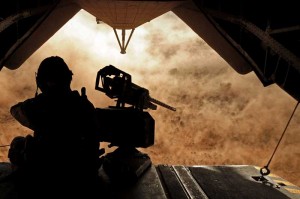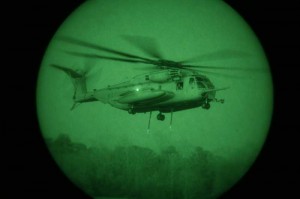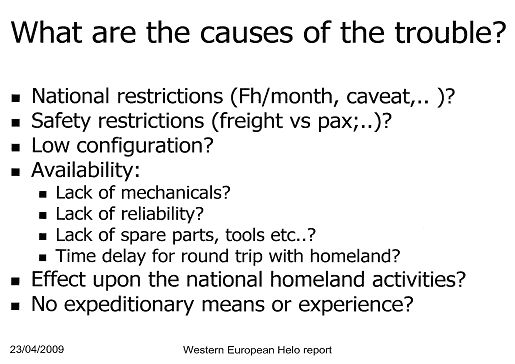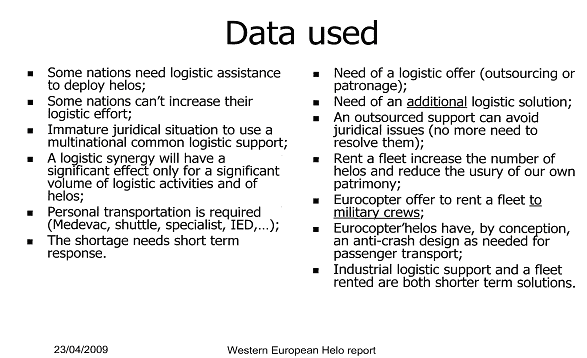By Robbin Laird and Murielle Delaporte
08/12/2009 – NATO is developing a common logistics initiative to support helicopters in operation in Afghanistan. It is clear that more helos are need for Afghan operations; but rather than simply inserting new kit, it is realized by senior NATO officials that shaping a common logistics initiative for those helicopters must be done to enhance capability. Simply inserting new kit without a significant improvement in in-theater logistics maintenance would be short-sighted and lead to significant capabilities short-falls, in the view of senior NATO officials. In an interview with senior OSD officials in the summer of 2009, sldinfo.com discussed the initiative.

The NATO initiative is really divided into three parallel efforts: one led by the US in shaping sustainment for North American-origin helos; the French with regard to West European-origin helos, and the Czechs with regard to East European origin-helos. The core effort is to get more capability out of the deployed fleet; rather than providing logistics support in home countries, the objective is to provide for logs and maintenance in theater, thereby gaining significant gains in deployment time for the fleet.
The Need for Enhanced Airpower in Afghanistan
At a time of American reinforcements in Afghanistan, the need for airpower is expected to go up substantially. Airpower is considered crucial in order to be able to hold vast amounts of terrain to prevent the Taliban from occupying or re-occuping the latter, as well as to facilitate a transition towards some kind of democratic process, with a key-election planned for August 20th.
The alternative to air routes is ground routes, which will get troops to their destination in hours as opposed to minutes (helicopters cover on average 3 to 4 miles a minute). Ground routes are, however, not only scarce (if not scarcer), but also very difficult, increasingly subject to attacks, and/or loaded with IEDs. In fact, the Taliban have made clear that their strategy is to make the roads as deadly as they can and statistics are there to prove it with an 80% increase in the use of roadside bombs this year, killing 172 troops and accounting for 60% of the total death rate in Afghanistan. Already in 2008, 3,276 IEDs were detected or detonated – a 45% increase over 2007 -, and the number of coalition deaths had already doubled reaching what was then considered an all-time high of 161. Ever since 2001, troops on the ground have indeed experienced the hard way that speed is crucial to the success of any operation in a country, whose half of its territory lies above 6,500 feet.
Given the nature of the terrain in Afghanistan and its landlocked characteristics, air power is the main source of mobility for troops allowing to save lives and limbs via close air support (CAS) and/or Medical evacuation (Medevac) capabilities; it is also a crucial reconnaissance and surveillance tool allowing the detection of enemy forces and IEDs. It also makes it possible for the troops to be there first and facilitate contact with a suspicious population. It is the most efficient tool to rapidly and successfully access remote areas and insurgents’ “safe havens.” And, finally, it is the safest way to re-supply the latter and protect indispensable logistics convoys.
Air power, and more to the point the right mix of air power, has however been the missing element of the coalition on the ground for the past years. “To fight Talibans in 14,000 feet-high mountains [the average altitude of the main mountain system, the Hindu Kush] facing an extraordinary agile enemy using donkeys for transportation, F-22s, JSFs or FA18 Super Hornets are not exactly fit. You need to get close to the enemy and you need to get at them fast”, the senior OSD official notes. “What you need are intra-theater lift capabilities provided by air assets such as the C130J and high-altitude helicopters, mostly the Chinooks (including the most recent upgraded version, the CH47Fs) and the CH53s, which the Marines used (including the last version, i.e. the CH53Es). You also need Apaches (AH64s), as well as Unmanned Aerial vehicles (UAVs). Furthermore, deplores the official, “existing mobile capabilities available in Afghanistan are not used efficiently”.
Even if airpower of growing significance, the shortfall is significant as well. The structural causes of the shortfall are multiple.
- An overextension and overuse of the fleet in harsh conditions are in part responsible for such a situation, as far as the United States (war in Iraq) and France (operations in Africa) in particular are concerned: the wear and tear of helicopters in recent years has been getting worse, as deployment has often to be extended to compensate for the lack of availability and as the next generation of equipment (e.g. V22; NH90) is becoming only slowly operational. Chinook airframes are cracked on a regular basis because of high-altitude flights in high winds and cold temperatures, while the sand tends to erode their floor panels and rotor blades.
- Conflicting demands with homeland security requirements are also a problem: as a matter of fact, the Chinooks helicopters were the rescue means of choice during the Katrina disaster in the United States.
- The lack of MRO (maintenance, repair and overhaul) capabilities is widespread among the International Security Assistance Force (ISAF) nations, either by lack of funding or lack of facilities: as far as Europe is concerned, only the UK, Spain, Italy Germany and France have such a capacity. Indeed, the cost related to helicopter support (in terms of MRO, but also in terms of in-theater warehousing) is especially heavy: in some cases, the price of one helicopter can actually double, once spares, tools, technical support and training are added. The cost of maintenance is in fact the very reason why, in 1991, the Mulroney government had sold its CH47 fleet to the Dutch and encountered as a result so many problems in terms of heavy lift once in Afghanistan a decade later. Maintaining the readiness of a fleet of helicopters is all the more demanding and expensive in extreme temperatures (hot and cold) and sandy conditions, with an estimated chopper rotation tempo of about three months and a scheduled maintenance having to be done obviously much more often than in peacetime. A rule of thumb is that to have 8 helicopters on the ground, about 30 have hence to be mobilized. The “reset” program set in place by the US Army ever since 2003 plans for the total disassembly, inspection and overhaul of the helos every 12 to 15 months (no upgrades), at a cost per aircraft estimated, as far as the Chinook is concerned, at $1.5 million.
- The lack of trained staff – both pilots and mechanics – is also a major concern, while not every country has an expeditionary tradition: renting air assets has been providing interim solutions till now on various theaters of operations, including Afghanistan, but the limits of these kinds of “rent-a-chopper deals” come when the latter become too dangerous, as civilian pilots do not want to – or cannot for legal reasons- take risks. The French-lead Task Force has proposed to solve this issue by setting up up a contracting agreement with a company to rent a fleet directly to trained military personnel.
- The lack of knowledge of each country’s capabilities, in terms of helicopters, spares, tools, consumables, MRO and staff, is one issue currently being addressed with the attempt to develop a common database of everyone’s inventories: this should also help to identify the roots of specific problems in each nation involved.
- The lack of common metrics to assess the real helicopter needs on the theater is another missing part of the puzzle.
- The “Black Hawk down syndrome” is another cause for scarce helicopter resources, as some nations are not willing to take too much risks: the Taliban is focusing on trying to down highly symbolic assets such as helicopters, especially if troops are on board, repeating the strategy successfully used in Afghanistan against the Soviets. In actual fact, because of the successful jamming of surface-to-air missiles by the coalition, the Taliban are using and seeking to acquire the exact same weapons which were used in the 1980’s, i.e. anti-aircraft artillery mounted on trucks to do so.
- The absence of a legal framework to allow the sharing of assets among coalition partners.
An Initiative is Born
The current challenge for the United States military leadership is to “surge” forces in Afghanistan, after having had to transfer the bulk of their forces into a very different kind of theater, i.e. Iraq. Just in terms of airfields, US forces could land in 8 to 9,000 different locations, as opposed to two main ones in Afghanistan. But besides the nature of the terrain and of the enemy, “one of the key issue and the main difference”, underscored a senior OSD official in our interview in June 2009, “is the fact that the coalition in Afghanistan deploys significant non-American forces”.
The availability and sharing of air assets in particular among allies have been the recurrent issue ever since the beginning of the conflict, not only because of the diversity of the deployed aircrafts, but because of a total lack of visibility about which country has what and the absence of coordination among nations, causing some helicopters to fly out half empty when needs for a ride had been clearly expressed by other countries. A key issue is the absence of agreed upon air-worthiness standards. This has been a key stumbling block to implementation of the agreement and a key focus of the NATO working group set up to come up with a common effort to provide for logistics support to NATO helos operating in Afghanistan.
“Hence, the decision taken by the North Atlantic Council in 2007 to identify ways to respond for this need for lift, as far as the most crucial equipment is concerned”, explains the senior offical. “After a year of consultations, it turns out that there is more lift than realized, but as in the case of Eastern European MI17s, most helicopters are not operationally ready nor fitted for combat in Afghanistan” The UK-French initiative, taken under the aegis of the European Defense Agency (EDA) in March 2008 and prompted by the situation in Afghanistan, but mostly at the time by the Darfur/Chad crisis, has simultaneously tried to solve the exact same issue, not only for Mi helicopters, but for all transport helicopters, and indeed, not exclusively for the Afghan theater. “Thanks to the UK-French initiative, the creation of a multi-national fund contributed to the refurbishing of Czech helicopters, but this has not – so far – been enough given the extent of maintenance required on the latter.”

Other initiatives such as the US Joint Precision Airdrop System, known as JPAD and co-developed by the US Air Force and the US Army ever since the early 1990’s, have in the past three years successfully delivered critical supplies (such as water and ammunition: see photo below) to troops on the ground from high-altitude flying aircrafts like the C130 and the C17 Globemaster III, thanks to a GPS system allowing the “self-steering” pallets to be dropped accurately into remote areas.
“The problem”, notes the senior official, “is that if JPAD does bring some supplies, it does not solve troop lift nor medical evacuation. The current fleet on the theater which actually does that is on the North American side, the CH47s, and the CH53, as well as, on the Western European side, the Pumas, Cougars and Super-Pumas, and on the Eastern European side, mostly the MI17s.” The American proposition has therefore been to develop an in-theater MRO process for these specific US equipment, starting with an emphasis on the CH47s, an initiative which looks very promising, as “the total demand for equipment has dropped significantly already,” the official adds.
According to the North American briefing at the Capellen seminar held in Luxembourg by the Senior NATO Logisticians Conference (SNLC) in January 2009 to shape the initaitive, the desired end state is to “field a collaborative helicopter logistics capability for ISAF CH47s, CH53s and AH64s by summer 2009 that improves effectiveness and efficiency of ISAF sortie generation. This will set the stage for potential future collaborative efforts for other helicopter types as well as making a large step forward in multinational logistics capabilities.” The US approach has been first to generate a dialog and gather information about making such an initiative happen among CH47 using nations in ISAF, i.e., the US, Canada, Italy, the Netherlands, Spain, the UK and Australia.

“A large number of NATO contributing troops in Afghanistan have been flying North American-origin helicopters, which were disassembled for maintenance and flown back to Europe”, explains one senior OSD official. “On–site maintenance would generally either be performed by governments or contractors. Via a “lessons learned” process done in cooperation with the contracting company L3, it has been possible to reduce the maintenance cycle immobilization time for the CH47 from 90 days down to 10 days.”
In order to address some of these issues, the North American working group has adopted an incremental approach identifying short, medium and long-term goals:
- The first milestone, which is currently under way, is to establish Allied Cross-Servicing Agreements (ACSA) in order to “enable operational and tactical sharing”, as well as exchange phase maintenance information;
- In the mid-term, the objectives are to “share spares information, improve logistics support, minimize the footprint, and reduce the strategic lift impact”: reducing supply costs and the strain on strategic lines of communications are the goals and the means to start the process have been, in addition to the development of implementing agreements, “the identification of obstacles to sharing information and the development of a database on in-theater stock levels”;
- Another mid-term goal expressed by the US-lead working group is to “identify and leverage common theater support services”: nations involved should provide a list of the “capabilities required to sustain helicopter operations (e.g. bench stock, oil analysis, tool calibration)”, as well as a list of “theater location and capacity of national capabilities”. The Capellen seminar was also an opportunity to stress the need to establish processes for sharing information and prioritize it among ISAF participants, examine ways to contract common services via NAMSA (NATO Maintenance and Supply Agency), and “explore the feasibility of collaborative training options”;
- In the longer term, the North American working group seeks to “provide efficient alternative to move national stocks forward to theater” via in-theater common strategic warehousing: a comparison of warehousing and airlift costs at home and in theater is required to move ahead with the recommendation.
An Innovative Process
The Pentagon has been able to speed up the implementation of the initial steps of the U.S. helicopter initiative in an innovative way by using a combination of two existing contracting devices, i.e. the Foreign Military Sales program (FMS) and the ACSA.
According to a senior OSD official, the FMS programs have allowed the United States to work rapidly on in-theater maintenance of US equipment with “the Canadians, the Australians, and the Dutch, with the Germans (on the CH53s) and with the Italians (who will purchase 10 CH47Ds in 2010) pending future agreements. It is also planned that the Spanish will purchase parts. There now exists a whole FMS supply chain, and many innovations are occurring in the process, because of the pressures of the war and the creativity of the Combatant Commanders”.
 The ACSA is one key tool used in the operations of the past few years, which has established a mechanism to allow the United States and its NATO allies to exchange logistical supplies (either in kind or equivalent, or against cash). According to a senior OSD official “Initiated in the 1980’s, ACSA is now blossoming and keeps expanding, as it is a flexible contracting vehicle. Logistics support, supply and services were provided on a bilateral basis among 32 nations and 3 organizations. Currently, the number of ACSA agreements has tripled to amount to 94.”
The ACSA is one key tool used in the operations of the past few years, which has established a mechanism to allow the United States and its NATO allies to exchange logistical supplies (either in kind or equivalent, or against cash). According to a senior OSD official “Initiated in the 1980’s, ACSA is now blossoming and keeps expanding, as it is a flexible contracting vehicle. Logistics support, supply and services were provided on a bilateral basis among 32 nations and 3 organizations. Currently, the number of ACSA agreements has tripled to amount to 94.”
Three Forward Operating Bases (FOBs) could set up correlated with each of the three groups – North American (US-lead), Western European (French-lead), and Eastern European (Czech-lead). The senior OSF official believes the time is ripe and the momentum is there “to find common solutions not only at the governmental level, but also within the industrial side (Boeing and Eurocopter could here have a common interest). This helicopter initiative has indeed now become a synergistic affair and nations are increasingly willing to participate.”
In short, OSD as well as European officials see the opportunity to shape common logistics approaches for in-theater helo operations. By creating common air-worthiness standards for each cluster of helos operating in Afghanistan, the nations can find ways to work towards common logistics solutions. And without achieving such solutions, according to the senior OSD official, “it will make little sense to introduce additional kit. We need to shape the public debate in the US about the need to recapitalize the rotorcraft fleet on the basis of having come up with solid approaches to logistics and maintenance.
N.B.: An earlier draft of this article was published in Military Logistics International (September-October 2009).
***
APPENDIX
A number of conclusions are being reached on the West European side as well with regard to the helo initiative. This initiative will be analyzed in a later article: for now some inserts from the April briefing suggest the flavor of the effort.



The quotes are taken directly from the briefing given to the NATO logistics group at the Capellen, Luxembourg meeting from January 20-23 2009.

